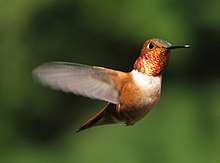Douglas Warrick
Douglas Warrick is an assistant professor in biophysics at the zoology department of Oregon State University, specializing in the study of functional/ecological morphology, aerodynamics, and the evolution of vertebrate flight, working with many bird species, including hummingbirds and seabirds.[1]
Career
Warrick worked for a biological consulting firm from 1987 to 1992, including work on the Exxon Valdez oil spill. Today he continues to participate in studies of seabird mortality from oil spills.[1] From 1999 to 2001 he was an assistant professor in biology at Minot State University in North Dakota. Since 2004 he has been at Oregon State University where his primary focus has been on hummingbirds and swifts.[1]
Hovering hummingbirds

In 2005, Warrick led a research study into the hummingbird's ability to hover in flight. Working with trained rufous hummingbirds (Selasphorus rufus) that hovered over a feeding syringe filled with sugar solution, Warrick and his research team employed digital particle imaging velocimetry to capture the bird's wing movements on film, which enabled the discovery that the hummingbird's hovering is achieved primarily because of its wing's downstroke (which accounts for 75% of its lift) rather than its upstroke (which makes up the additional 25% of the lift). This was counter to the conventional wisdom which was that the lift was provided 50:50 by the up and down strokes as with hawk moths.[2][3][4] Warrick's research was published in Nature, a leading scientific journal, and his research conclusions were widely reported in the international media such as Scientific American, the BBC, the Associated Press news wire, and the United States National Science Foundation.[1][5][6][7]
Inspiration for art
Warrick et al.'s Nature (2005) article inspired Jennifer MacMillan and Bradley Eros to create their own "experiment" - investigating the "cross-pollination of scientific visualization and poetic document". Their art work added "star studies, satellite recordings, subaquatic and botanical investigations, liquid crystals, visual music performance generated from the scientific instrument, high speed motion studies, a discussion of subatomic physics, and readings of the 10 most beautiful experiments of science."[8]
Selected publications
- Douglas R. Warrick, Bret W. Tobalske, Donald R. Powers (2009) Lift production in the hovering hummingbird, Proceedings of the Royal Society B: Biological Sciences, Vol. 276, No. 1674. (7 November), pp. 3747–3752.
- Bret W. Tobalske, Jason W. D. Hearn and Douglas R. Warrick (2009) Aerodynamics of intermittent bounds in flying birds, Experiments in Fluids Volume 46, Number 5 / May, 2009
- Douglas R. Warrick, Bret W. Tobalske & Donald R. Powers (2005) Aerodynamics of the hovering hummingbird, Nature 435, 1094-1097 23 June
- K. P. Dial, A. A. Biewener, B. W. Tobalske & D. R. Warrick (1997) Mechanical power output of bird flight, Nature 390, 67-70 6 November
References
- "Douglas R. Warrick: Assistant Professor". Oregon State University. 2010. Archived from the original on 2011-07-09. Retrieved 2011-02-13.
- "Master fliers of the bird kingdom". BBC. June 27, 2005. Retrieved 2009-10-30.
- McCall, William (June 6, 2005). "Study says hummingbirds fly more like birds than insects". The Seattle Times. Archived from the original on June 4, 2011. Retrieved 2009-10-30.
- "High-Tech Pictures Reveal How Hummingbirds Hover". Scientific American. June 25, 2005. Retrieved 2009-10-30.
- "George Fox Professor's Hummingbird Research Published in Journal Nature". George Fox University. June 22, 2005. Archived from the original on 2006-09-01. Retrieved 2006-11-11.
- "Aerodynamics of the hovering hummingbird". Nature. June 23, 2005. Retrieved 2006-11-11.
- "Ultra-Fast Camera Captures How Hummingbirds Hover" (Press release). National Science Foundation.
- "Invisible Cinema: Living experimental film and video, The Aerodynamics of the Hovering Hummingbird: Science, Cinema, and Ways of Seeing".
External links
- Douglas R. Warrick faculty page at Oregon State University